10 Rare Pocket Watches From the Early 1900s That Still Keep Time
Pocket watches from the early 1900s are a fascinating piece of history, blending intricate craftsmanship with practical design. These timepieces were once a staple in daily life, but today, they hold a unique place in the world of collectibles. What makes them even more special is that many of these rare pocket watches still keep time, despite their age. Their enduring quality and timeless appeal make them highly sought after by collectors. Join us as we explore these exceptional watches that have stood the test of time.
This post may contain affiliate links, which helps keep this content free. Please read our disclosure for more info.
Patek Philippe Pocket Watch

This watch dates to around 1905 and was made by Patek Philippe in Geneva. It stands out because of its solid gold case, high-grade movement and rarity of surviving pieces in full working order. The fact it still runs after more than a century adds to its appeal. On the market today examples of this sort may go for around US$600,000-1,000,000 depending on condition and provenance. It’s useful to note that securing an extract of archives or original paperwork can raise value further.
Many such watches were originally made for private clients or special retailers, which makes individual examples unique. Some were delivered with very limited production numbers, making them much harder to find. When they are kept in good working condition they are quite special among collectors. Because the movement quality and case materials were premium at the time, such pieces have a respect in the horology world. If you are looking at one of these, checking for original dial, gold hallmark and movement numbers is important.
Patek Philippe x Tiffany and Co Pocket Watch
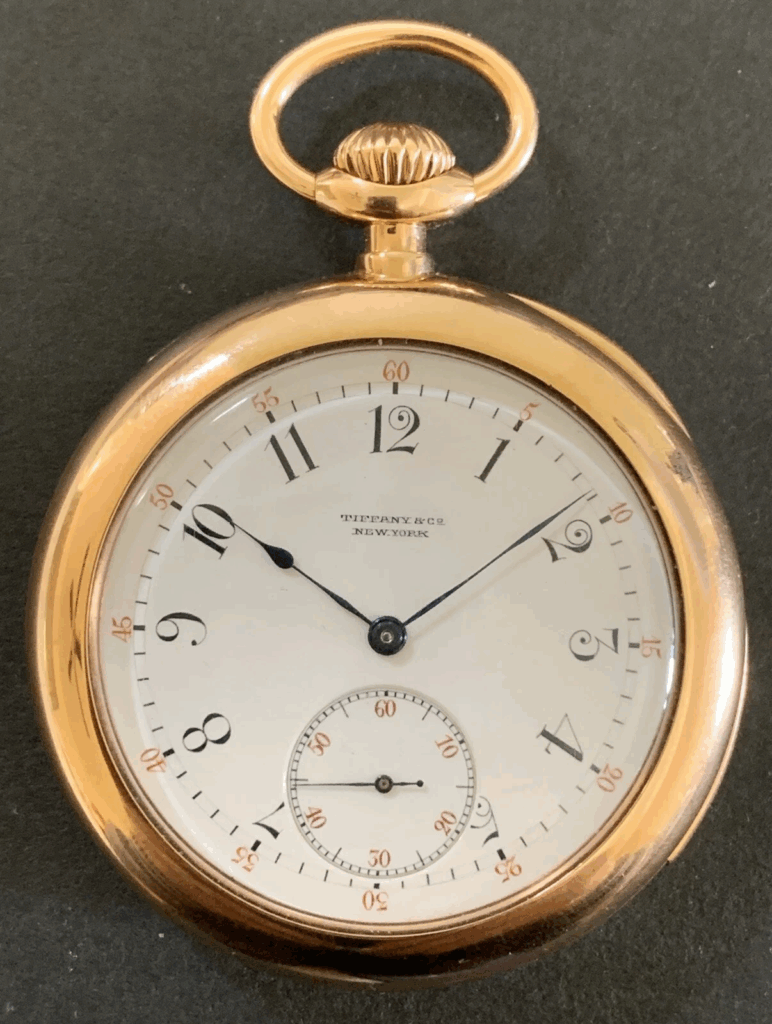
Produced in the very early 1900s, this example is double-signed by Patek Philippe and Tiffany and Co., and encased in 18-karat yellow gold. Double-signing by two prestigious houses makes it especially rare. It remains operational which adds to its desirability. Estimated market values often run in the region of US$400,000-800,000, sometimes higher if the chain, box or papers are included. Collectors often pay more for pieces with provenance or strong original condition.
Because it was retailed by Tiffany and Co. in the United States, this piece carries extra historical interest and likely fewer survivors. Full working condition is less common given age and mechanical complexity. The gold case, large size (54 mm plus) and name pairing help set it apart. Buyers should check that the hands, dial and case are original or period correct. It also makes a strong show-piece for those interested in both horology and luxury heritage.
Baume and Mercier 18 ct Gold Pocket Watch
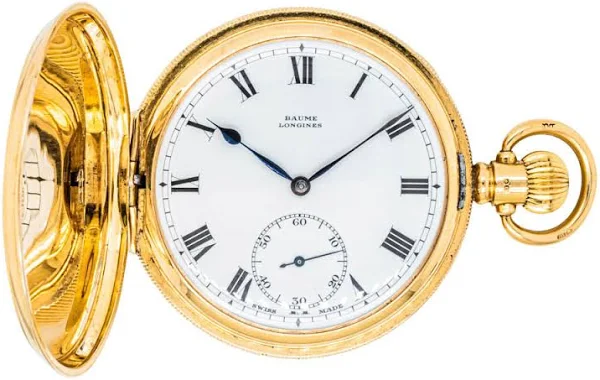
This watch comes from the brand Baume and Mercier and dates to the early 1900s. The solid 18-carat gold case and fine Swiss movement create a rarity among gold-cased Swiss pocket watches of this period. It is reported to keep time, which is significant for its age. On current market listings similar items might fetch around US$5,000-10,000 depending on condition. Given the less extreme prices compared to ultra-high-end makers, this model offers an accessible entry into rare early 20th-century gold pocket watches.
With more manageable cost compared to the very top brands, this type of watch can appeal to collectors seeking quality without six-figure sums. The fact that it remains in working condition elevates its status above non-functional examples. Gold-case pocket watches are more vulnerable to wear, so survival in good shape matters. Originality of dial and hands will affect value significantly. For those with interest in early wrist-watch era transitions, such a pocket watch also represents a period of change in watchmaking.
WWI Era Military Pocket Watch
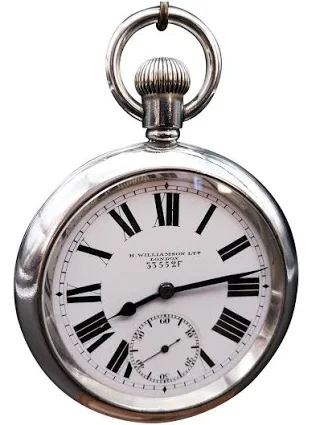
Manufactured around 1915, this pocket watch served in or mirrored the design cues of military timepieces from the First World War era. Its rarity comes from it being survivor from a heavy-use period and the fewer examples that remain running. It continues to tick, which is impressive given wear over more than a hundred years. Estimated value for similar pieces with verified provenance might be about US$2,000-5,000, depending on condition, case material, maker and functionality. Military watches often have special attractive features like large size, rail-type calibres or historical engravings.
Because wartime production sometimes meant reduced finish or modifications, examples with full original equipment are rarer. A working movement, intact dial and correct case back engravings enhance appeal. The size and style may reflect the transition from pocket to wrist-watches of the period. Checking for oiling, service history and case condition is wise if acquiring one. For a collector interested in historical context rather than luxury branding alone, this kind of item holds charm.
Patek Philippe Yellow Gold Pocket Watch

This pocket watch is dated to the end of the 19th century or very early 1900s and made by Patek Philippe in yellow gold. Its rarity stems from its age, material, brand prestige and survival in working condition more than a century later. The continual timekeeping function heightens its value. Current online listings for very similar items show asking prices around US$300,000-600,000, sometimes higher for exceptional condition. Because it straddles the turn-of-the-century period, its design and mechanics reflect an important transition in watchmaking.
The case design, movement finishing and hallmarks should be carefully examined for originality. Watches of this era may have undergone repairs, so documentation helps. This piece represents both horological heritage and investment interest. Wear even on the case or dial can reduce value, so condition matters. Those who study early 20th-century luxury watches will find this pocket watch particularly meaningful.
Patek Philippe Hunter Case 18 ct Gold Pocket Watch
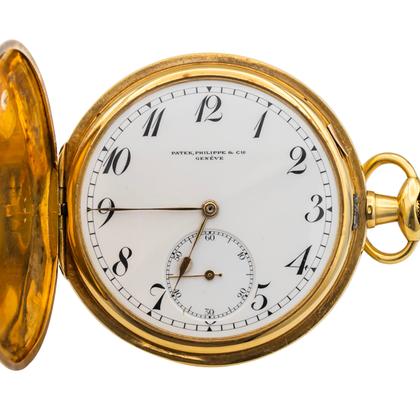
Made around 1915, this Patek Philippe piece features a hunter-case (lid covering the dial) in 18-carat yellow gold. The combination of high-quality maker, full gold case and period hunter design makes it rare in an increasing market of survivors. It is reported to still run, which enhances its collectible status. Market value for this type of item is in the region of US$400,000-700,000 depending on size, condition, provenance and complexity. Collectors especially prize such pieces when they include period chain or presentation case.
Hunter-case watches were common earlier, but few premium brand models from this era survive intact. The gold case adds weight and value, and the guard lid protects the dial and crystal, helping preservation. Ensuring correct movement serial number and maker marking is part of evaluation. Given its brand and materials, servicing history matters for sustained time-keeping. In sum this is a fine example of high-grade pocket watch production from early 1900s.
Antique Silver Pocket Watch Circa 1900

This silver-cased pocket watch originates around 1900 and is described as working. Its rarity comes from its age, original silver case (which is less common than gold) and functional movement after so many years. For examples in good condition, current sales suggest values in the range of US$500-2,000 depending on maker and condition. Silver-cased early pocket watches often represent a more accessible entry point for collectors of this era. Because it still keeps time, its practical appeal increases.
While gold cases usually fetch higher prices, silver cases can be very desirable when the maker is reputable and the movement fine. Attention should be paid to dial condition, movement cleanliness and case wear. Serving as daily-worn items in their era, these pieces often show patina or wear that collectors may accept as character. Researching serial numbers and maker marks helps establish authenticity and date. Because it continues to function, this pocket watch offers both historical interest and tangible operational merit.
Patek Philippe Lepine Pocket Watch
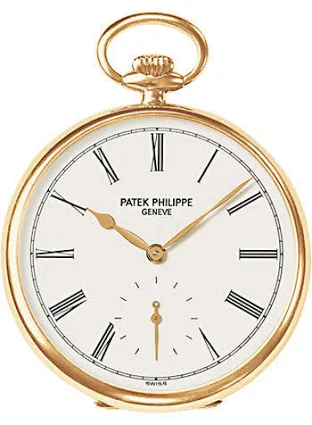
Created in the early 1900s, this Lepine-style pocket watch from Patek Philippe is large format (around 51mm diameter) and carried a high-grade calibre. Its rarity comes from size, brand and survival of unit in working condition. Value estimates for such high-end pocket watches may run US$500,000, depending on complication, case material and condition. The Lepine style (open face with crown at 12 o’clock) was a standard for formal watches of the period. For a collector interested in early premium pocket watches this model is noteworthy.
Large size watches were less common and more expensive to produce at that time, adding to their rarity. The condition of dial, case and movement slides into importance when assessing value. Having a major brand like Patek Philippe further raises interest from global collectors. A working movement after more than 100 years is a sign of careful ownership and servicing. When you see one of these in good condition it offers a glimpse of watchmaking excellence from the period.
Gold-Plated Half-Hunter Pocket Watch

This pocket watch dates to around 1900, features a gold-plated case and half-hunter design (window on the lid to view the dial). It is rarer than many gold-filled models because gold plating was less common at luxury levels then, and survivors in working condition are fewer. Market value for such gold-plated watches in good order can be in the region of US$1,000-3,000, though maker and condition could push price higher. It remains ticking which adds operational appeal for a watch of its era. The half-hunter style gives it a distinctive look while preserving protection of the dial.
Gold-plated cases often show wear, so an example with modest wear is more desirable. The small window in the lid allowed the time to be read without opening the case, a functional feature of the time. Movement condition, correct case hinges and intact crystal will add to desirability. For someone collecting early 20th-century pocket watches on a moderate budget this is an interesting option. It shows how the form and function of timepieces were evolving at that time.
This article originally appeared on Avocadu.
